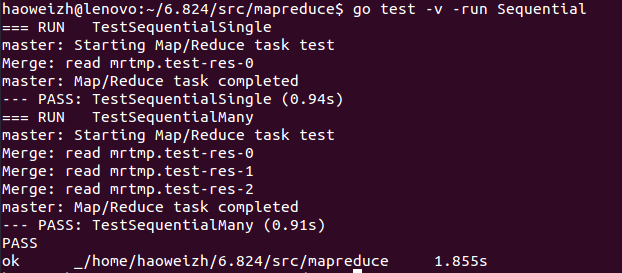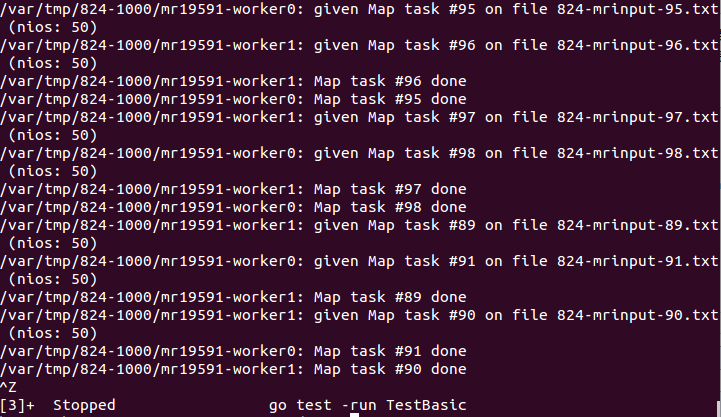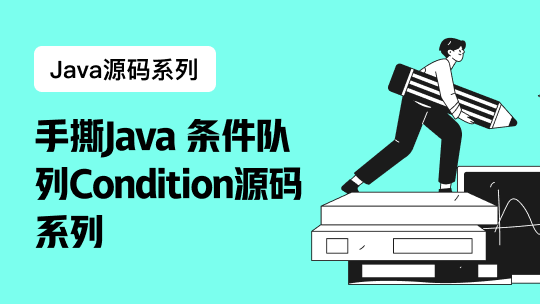github:https://github.com/haoweiz/MIT-6.824
Part1:
第一部分比较简单,我们只需要修改doMap和doReduce函数即可,主要涉及Go语言对Json文件的读写。简单说说part1的测试流程吧,Sequential部分代码如下
1 func TestSequentialSingle(t *testing.T) {
2 mr := Sequential("test", makeInputs(1), 1, MapFunc, ReduceFunc)
3 mr.Wait()
4 check(t, mr.files)
5 checkWorker(t, mr.stats)
6 cleanup(mr)
7 }
8
9 func TestSequentialMany(t *testing.T) {
10 mr := Sequential("test", makeInputs(5), 3, MapFunc, ReduceFunc)
11 mr.Wait()
12 check(t, mr.files)
13 checkWorker(t, mr.stats)
14 cleanup(mr)
makeInputs(M int)对于0-100000个数字平均分成了M个文件写入,,根据题目要求,我们需要将每个文件分成N个文件写出,因此doMap过程总共产生M*N个文件,我们可以先将文件的所有键值对通过mapF函数(本质上是test_test.go中的MapFunc函数)存储在数组keyvalue中,然后创建nReduce个文件并对每个键值对用ihash()%nReduce得到该键值对应存储的文件位置,利用Encoder写入文件即可
1 // doMap manages one map task: it reads one of the input files
2 // (inFile), calls the user-defined map function (mapF) for that file's
3 // contents, and partitions the output into nReduce intermediate files.
4 func doMap(
5 jobName string, // the name of the MapReduce job
6 mapTaskNumber int, // which map task this is
7 inFile string,
8 nReduce int, // the number of reduce task that will be run ("R" in the paper)
9 mapF func(file string, contents string) []KeyValue,
10 ) {
11 //
12 // You will need to write this function.
13 //
14 // The intermediate output of a map task is stored as multiple
15 // files, one per destination reduce task. The file name includes
16 // both the map task number and the reduce task number. Use the
17 // filename generated by reduceName(jobName, mapTaskNumber, r) as
18 // the intermediate file for reduce task r. Call ihash() (see below)
19 // on each key, mod nReduce, to pick r for a key/value pair.
20 //
21 // mapF() is the map function provided by the application. The first
22 // argument should be the input file name, though the map function
23 // typically ignores it. The second argument should be the entire
24 // input file contents. mapF() returns a slice containing the
25 // key/value pairs for reduce; see common.go for the definition of
26 // KeyValue.
27 //
28 // Look at Go's ioutil and os packages for functions to read
29 // and write files.
30 //
31 // Coming up with a scheme for how to format the key/value pairs on
32 // disk can be tricky, especially when taking into account that both
33 // keys and values could contain newlines, quotes, and any other
34 // character you can think of.
35 //
36 // One format often used for serializing data to a byte stream that the
37 // other end can correctly reconstruct is JSON. You are not required to
38 // use JSON, but as the output of the reduce tasks *must* be JSON,
39 // familiarizing yourself with it here may prove useful. You can write
40 // out a data structure as a JSON string to a file using the commented
41 // code below. The corresponding decoding functions can be found in
42 // common_reduce.go.
43 //
44 // enc := json.NewEncoder(file)
45 // for _, kv := ... {
46 // err := enc.Encode(&kv)
47 //
48 // Remember to close the file after you have written all the values!
49 //
50
51 // Read from inFile and save all keys and values in keyvalue
52 var keyvalue []KeyValue
53 fi, err := os.Open(inFile)
54 if err != nil {
55 log.Fatal("doMap Open: ", err)
56 }
57 defer fi.Close()
58 br := bufio.NewReader(fi)
59 for {
60 a, _, c := br.ReadLine()
61 if c == io.EOF {
62 break
63 }
64 kv := mapF(inFile, string(a))
65 for i := 0; i != len(kv); i++ {
66 keyvalue = append(keyvalue, kv[i])
67 }
68 }
69
70 // Create nReduce files and create encoder for each of them
71 var names []string
72 files := make([]*os.File, 0, nReduce)
73 enc := make([]*json.Encoder, 0, nReduce)
74 for r := 0; r != nReduce; r++ {
75 names = append(names, fmt.Sprintf("mrtmp.%s-%d-%d", jobName, mapTaskNumber, r))
76 file, err := os.Create(names[r])
77 if err != nil {
78 log.Fatal("doMap Create: ", err)
79 }
80 files = append(files, file)
81 enc = append(enc, json.NewEncoder(file))
82 }
83
84 // Choose which file to store for each keyvalue
85 for _, kv := range keyvalue {
86 index := ihash(kv.Key)%nReduce
87 enc[index].Encode(kv)
88 }
89
90 // Close all files
91 for _, f := range files {
92 f.Close()
93 }
94 }
对于doReduce函数我们需要读取nMap个文件,将所有键值对解码并重新编码写出到outFile中
1 // doReduce manages one reduce task: it reads the intermediate
2 // key/value pairs (produced by the map phase) for this task, sorts the
3 // intermediate key/value pairs by key, calls the user-defined reduce function
4 // (reduceF) for each key, and writes the output to disk.
5 func doReduce(
6 jobName string, // the name of the whole MapReduce job
7 reduceTaskNumber int, // which reduce task this is
8 outFile string, // write the output here
9 nMap int, // the number of map tasks that were run ("M" in the paper)
10 reduceF func(key string, values []string) string,
11 ) {
12 //
13 // You will need to write this function.
14 //
15 // You'll need to read one intermediate file from each map task;
16 // reduceName(jobName, m, reduceTaskNumber) yields the file
17 // name from map task m.
18 //
19 // Your doMap() encoded the key/value pairs in the intermediate
20 // files, so you will need to decode them. If you used JSON, you can
21 // read and decode by creating a decoder and repeatedly calling
22 // .Decode(&kv) on it until it returns an error.
23 //
24 // You may find the first example in the golang sort package
25 // documentation useful.
26 //
27 // reduceF() is the application's reduce function. You should
28 // call it once per distinct key, with a slice of all the values
29 // for that key. reduceF() returns the reduced value for that key.
30 //
31 // You should write the reduce output as JSON encoded KeyValue
32 // objects to the file named outFile. We require you to use JSON
33 // because that is what the merger than combines the output
34 // from all the reduce tasks expects. There is nothing special about
35 // JSON -- it is just the marshalling format we chose to use. Your
36 // output code will look something like this:
37 //
38 // enc := json.NewEncoder(file)
39 // for key := ... {
40 // enc.Encode(KeyValue{key, reduceF(...)})
41 // }
42 // file.Close()
43 //
44
45 // Read all mrtmp.xxx-m-reduceTaskNumber and write to outFile
46 var names []string
47 file, err := os.Create(outFile)
48 if err != nil {
49 log.Fatal("doReduce Create: ", err)
50 }
51 enc := json.NewEncoder(file)
52 defer file.Close()
53
54 // Read all contents from mrtmp.xxx-m-reduceTaskNumber
55 kvs := make(map[string][]string)
56 for m := 0; m != nMap; m++ {
57 names = append(names, fmt.Sprintf("mrtmp.%s-%d-%d", jobName, m, reduceTaskNumber))
58 fi, err := os.Open(names[m])
59 if err != nil {
60 log.Fatal("doReduce Open: ", err)
61 }
62 dec := json.NewDecoder(fi)
63 for {
64 var kv KeyValue
65 err = dec.Decode(&kv)
66 if err != nil {
67 break
68 }
69 kvs[kv.Key] = append(kvs[kv.Key], kv.Value)
70 }
71 fi.Close()
72 }
73 for k, v := range kvs {
74 enc.Encode(KeyValue{k, reduceF(k, v)})
75 }
76 }
通过测试

Part2:
第二部分建立在第一部分的基础上,要进行词频统计,就很简单,对于mapF函数我们产生键值对,对于reduceF函数我们返回值出现的次数即可
1 //
2 // The map function is called once for each file of input. The first
3 // argument is the name of the input file, and the second is the
4 // file's complete contents. You should ignore the input file name,
5 // and look only at the contents argument. The return value is a slice
6 // of key/value pairs.
7 //
8 func mapF(filename string, contents string) []mapreduce.KeyValue {
9 // TODO: you have to write this function
10 f := func(c rune) bool {
11 return !unicode.IsLetter(c)
12 }
13 words := strings.FieldsFunc(contents, f)
14 var keyvalue []mapreduce.KeyValue
15 for _, word := range words {
16 keyvalue = append(keyvalue, mapreduce.KeyValue{word,""})
17 }
18 return keyvalue
19 }
20
21 //
22 // The reduce function is called once for each key generated by the
23 // map tasks, with a list of all the values created for that key by
24 // any map task.
25 //
26 func reduceF(key string, values []string) string {
27 // TODO: you also have to write this function
28 return strconv.Itoa(len(values))
29 }
通过测试

Part3:
这一部分有点难,主要是对Go的并发机制要有一些了解才能做,阅读源代码,这个测试将100000以内的数字生成了100个文件,即100个Map任务,并产生50个Reduce任务,同时产生了两个worker,当全部map结束后进入reduce,所以schedule被调用了两次,先整体把握下该怎么写,由于这次需要分布式计算,所以我们可以分配ntasks个go程每次从registerChan中得到一个空闲的worker后调用call函数分配任务,然后结束后重新将其放到registerChan中(这里是第一个小坑,原本以为call函数调用结束后会自动将worker重新放入registerChan中,后来发现registerChan根本没有作为参数传入call函数,自然不能实现这个操作)
1 func TestBasic(t *testing.T) {
2 mr := setup()
3 for i := 0; i < 2; i++ {
4 go RunWorker(mr.address, port("worker"+strconv.Itoa(i)),
5 MapFunc, ReduceFunc, -1)
6 }
7 mr.Wait()
8 check(t, mr.files)
9 checkWorker(t, mr.stats)
10 cleanup(mr)
11 }
阅读文档可知这一部分的核心是call函数,用于任务的分配。
1 // call() sends an RPC to the rpcname handler on server srv
2 // with arguments args, waits for the reply, and leaves the
3 // reply in reply. the reply argument should be the address
4 // of a reply structure.
5 //
6 // call() returns true if the server responded, and false
7 // if call() was not able to contact the server. in particular,
8 // reply's contents are valid if and only if call() returned true.
9 //
10 // you should assume that call() will time out and return an
11 // error after a while if it doesn't get a reply from the server.
12 //
13 // please use call() to send all RPCs, in master.go, mapreduce.go,
14 // and worker.go. please don't change this function.
15 //
16 func call(srv string, rpcname string,
17 args interface{}, reply interface{}) bool {
18 c, errx := rpc.Dial("unix", srv)
19 if errx != nil {
20 return false
21 }
22 defer c.Close()
23
24 err := c.Call(rpcname, args, reply)
25 if err == nil {
26 return true
27 }
28
29 fmt.Println(err)
30 return false
31 }
首先我们需要明确四个参数的值,文档中说了,第一个参数从registerChan中获得,第二个参数是给定的字符串"Worker.DoTask",第四个参数是nil,第三个参数是个结构体DoTaskArgs,看看这个结构体长啥样
1 // What follows are RPC types and methods.
2 // Field names must start with capital letters, otherwise RPC will break.
3
4 // DoTaskArgs holds the arguments that are passed to a worker when a job is
5 // scheduled on it.
6 type DoTaskArgs struct {
7 JobName string
8 File string // only for map, the input file
9 Phase jobPhase // are we in mapPhase or reducePhase?
10 TaskNumber int // this task's index in the current phase
11
12 // NumOtherPhase is the total number of tasks in other phase; mappers
13 // need this to compute the number of output bins, and reducers needs
14 // this to know how many input files to collect.
15 NumOtherPhase int
16 }
再对照schedule的参数赋值即可,所有参数均有对应。基本上了解了以上几点可以得到下面的代码,和上面的思路一样,创建ntasks个go程,然后将doTaskArgs参数设置好,连同registerChan一并传入,一旦channel中有空闲的worker,随机找一个被阻塞的go程运行即可,因为都是并发的,所以谁先执行都没关系,然后用waitGroup阻塞主程,看起来很完美,但运行一半时会卡住,这是这个部分最大的坑,现在来分析下原因。
咱们先反复运行一下测试,发现得到下面的信息,仔细观察可以发现,这90和91号任务已经是最后两个任务了,为什么到最后会卡住,这是因为channel是阻塞式的(Distributed函数中定义channel时并未为其分配缓存),当倒数第二个任务完成后重新加到channel中时,已经没有go程会取出这个worker了,此时最后一个go程再想将worker添加到channel中时就会阻塞,所以这个代码会阻塞在最后一个go程的下面代码的第八行。

1 var wg sync.WaitGroup
2 wg.Add(ntasks)
3 for i := 0; i != ntasks; i++ {
4 doTaskArgs := DoTaskArgs{jobName, mapFiles[i] , phase, i, n_other}
5 go func(doTaskArgs DoTaskArgs, registerChan chan string) {
6 address := <-registerChan
7 call(address, "Worker.DoTask", doTaskArgs, nil)
8 registerChan <- address
9 wg.Done()
10 return
11 }(doTaskArgs, registerChan)
12 }
13 wg.Wait()
最简单的做法就是为第八行创建一个新协程,这样最后一个任务虽然无法添加到channel中,但由于它是另一个go程,所以当主程退出后,这个子程虽然还阻塞着,但也会强制退出。修改方式修改后得到如下代码
1 //
2 // schedule() starts and waits for all tasks in the given phase (Map
3 // or Reduce). the mapFiles argument holds the names of the files that
4 // are the inputs to the map phase, one per map task. nReduce is the
5 // number of reduce tasks. the registerChan argument yields a stream
6 // of registered workers; each item is the worker's RPC address,
7 // suitable for passing to call(). registerChan will yield all
8 // existing registered workers (if any) and new ones as they register.
9 //
10 func schedule(jobName string, mapFiles []string, nReduce int, phase jobPhase, registerChan chan string) {
11 var ntasks int
12 var n_other int // number of inputs (for reduce) or outputs (for map)
13 switch phase {
14 case mapPhase:
15 ntasks = len(mapFiles)
16 n_other = nReduce
17 case reducePhase:
18 ntasks = nReduce
19 n_other = len(mapFiles)
20 }
21
22 fmt.Printf("Schedule: %v %v tasks (%d I/Os)\n", ntasks, phase, n_other)
23
24 // All ntasks tasks have to be scheduled on workers, and only once all of
25 // them have been completed successfully should the function return.
26 // Remember that workers may fail, and that any given worker may finish
27 // multiple tasks.
28 //
29 // TODO TODO TODO TODO TODO TODO TODO TODO TODO TODO TODO TODO TODO
30 //
31 var wg sync.WaitGroup
32 wg.Add(ntasks)
33 for i := 0; i != ntasks; i++ {
34 doTaskArgs := DoTaskArgs{jobName, mapFiles[i] , phase, i, n_other}
35 go func(doTaskArgs DoTaskArgs, registerChan chan string) {
36 address := <-registerChan
37 call(address, "Worker.DoTask", doTaskArgs, nil)
38 go func() {
39 registerChan <- address
40 }()
41 wg.Done()
42 return
43 }(doTaskArgs, registerChan)
44 }
45 wg.Wait()
46 fmt.Printf("Schedule: %v phase done\n", phase)
47 }
通过测试

Part4:
有了第三部分铺垫,这一部分就非常简单了,如果worker失效,那么call函数会返回false,此时我们需要从channel中获得下一个worker直到call返回true为止,因此将获取worker和call函数放在一个for循环中即可。
1 //
2 // schedule() starts and waits for all tasks in the given phase (Map
3 // or Reduce). the mapFiles argument holds the names of the files that
4 // are the inputs to the map phase, one per map task. nReduce is the
5 // number of reduce tasks. the registerChan argument yields a stream
6 // of registered workers; each item is the worker's RPC address,
7 // suitable for passing to call(). registerChan will yield all
8 // existing registered workers (if any) and new ones as they register.
9 //
10 func schedule(jobName string, mapFiles []string, nReduce int, phase jobPhase, registerChan chan string) {
11 var ntasks int
12 var n_other int // number of inputs (for reduce) or outputs (for map)
13 switch phase {
14 case mapPhase:
15 ntasks = len(mapFiles)
16 n_other = nReduce
17 case reducePhase:
18 ntasks = nReduce
19 n_other = len(mapFiles)
20 }
21
22 fmt.Printf("Schedule: %v %v tasks (%d I/Os)\n", ntasks, phase, n_other)
23
24 // All ntasks tasks have to be scheduled on workers, and only once all of
25 // them have been completed successfully should the function return.
26 // Remember that workers may fail, and that any given worker may finish
27 // multiple tasks.
28 //
29 // TODO TODO TODO TODO TODO TODO TODO TODO TODO TODO TODO TODO TODO
30 //
31 var wg sync.WaitGroup
32 wg.Add(ntasks)
33 for i := 0; i != ntasks; i++ {
34 doTaskArgs := DoTaskArgs{jobName, mapFiles[i] , phase, i, n_other}
35 go func(doTaskArgs DoTaskArgs, registerChan chan string) {
36 success := false
37 var address string
38 for success==false {
39 address = <-registerChan
40 success = call(address, "Worker.DoTask", doTaskArgs, nil)
41 }
42 go func() {
43 registerChan <- address
44 }()
45 wg.Done()
46 }(doTaskArgs, registerChan)
47 }
48 wg.Wait()
49 fmt.Printf("Schedule: %v phase done\n", phase)
50 }
通过测试

Part5:
第五部分让我们实现一个inverted index,说白了就是每个出现过的单词->所有出现过该单词的文件,所以map过程输出单词->文件名,reduce过程构建所有独一无二的文件个数(利用哈希表,因为一个单词可能在同一文件出现多次,所以要去除重复文件名)以及所有文件名组成的长字符串(注意需要进行排序)。注意那个源代码上的注释有点误导人,忽略即可。
1 // The mapping function is called once for each piece of the input.
2 // In this framework, the key is the name of the file that is being processed,
3 // and the value is the file's contents. The return value should be a slice of
4 // key/value pairs, each represented by a mapreduce.KeyValue.
5 func mapF(document string, value string) (res []mapreduce.KeyValue) {
6 // TODO: you should complete this to do the inverted index challenge
7 f := func(c rune) bool {
8 return !unicode.IsLetter(c)
9 }
10 words := strings.FieldsFunc(value, f)
11 for _, word := range words {
12 res = append(res, mapreduce.KeyValue{word, document})
13 }
14 return
15 }
16
17 // The reduce function is called once for each key generated by Map, with a
18 // list of that key's string value (merged across all inputs). The return value
19 // should be a single output value for that key.
20 func reduceF(key string, values []string) string {
21 // TODO: you should complete this to do the inverted index challenge
22 m := make(map[string]string)
23 for _, value := range values {
24 m[value] = value
25 }
26 var uniqueValues []string
27 for _, value := range m {
28 uniqueValues = append(uniqueValues, value)
29 }
30 sort.Strings(uniqueValues)
31 s := strconv.Itoa(len(m))
32 s += " "
33 s += uniqueValues[0]
34 for i := 1; i != len(uniqueValues); i++ {
35 s += ","
36 s += uniqueValues[i]
37 }
38 return s
39 }
通过所有测试












